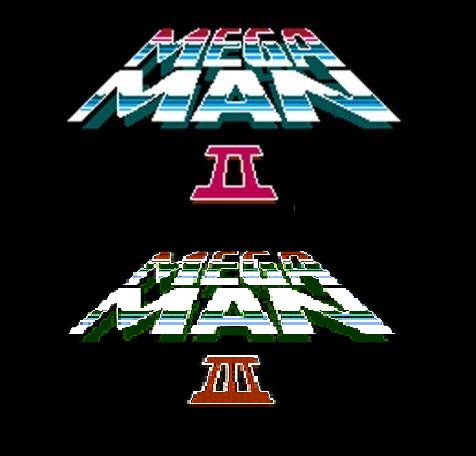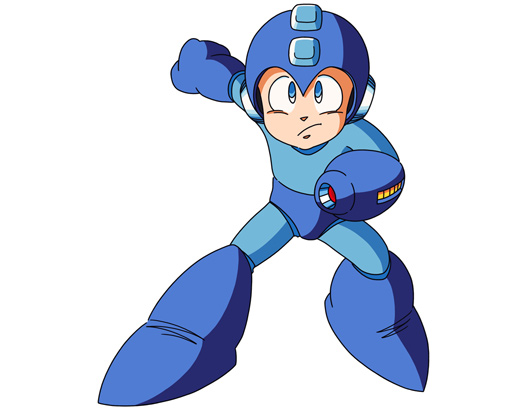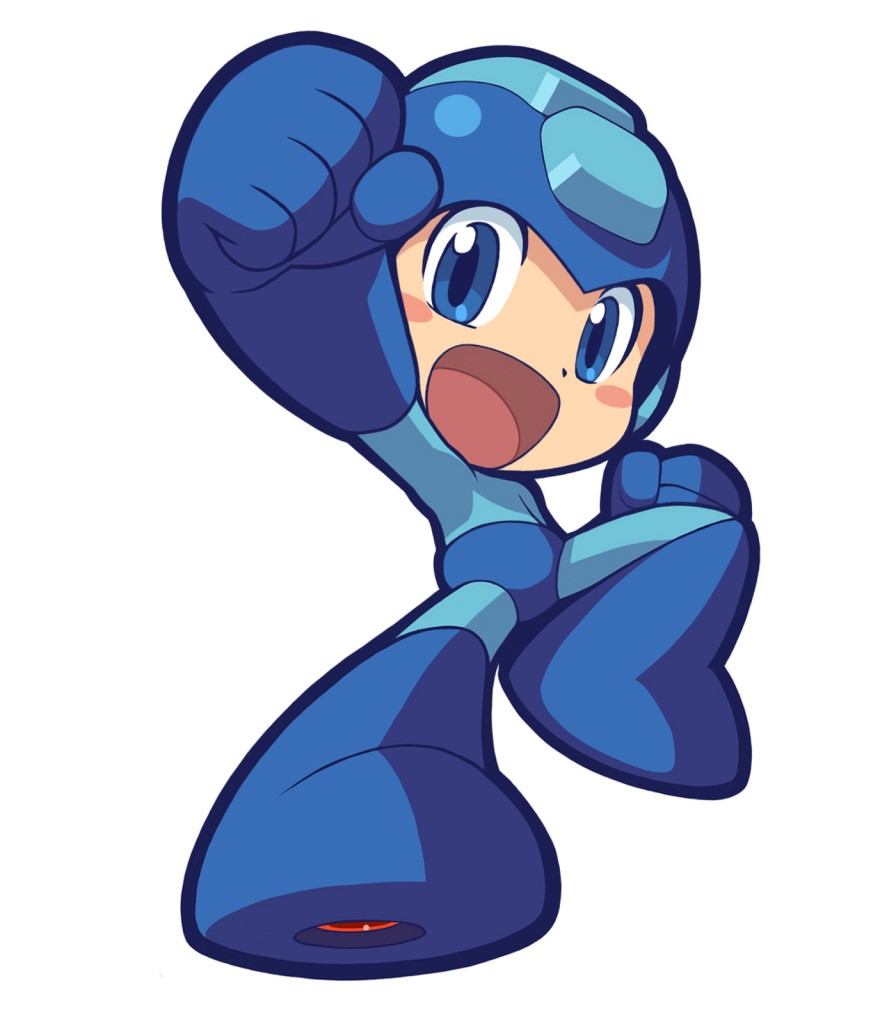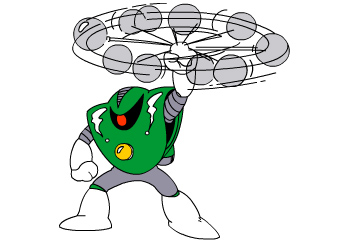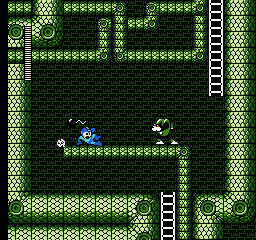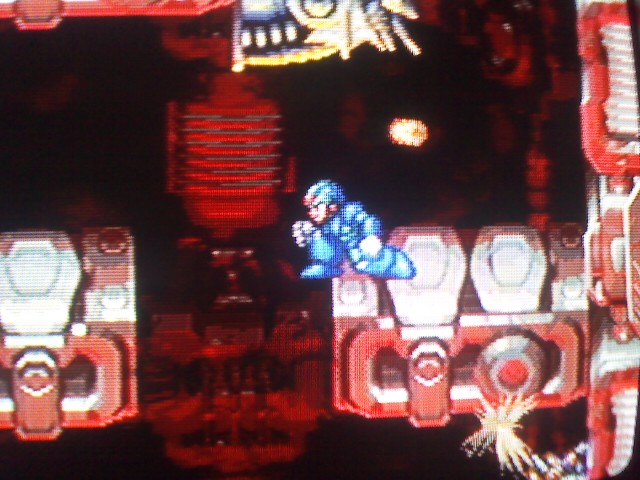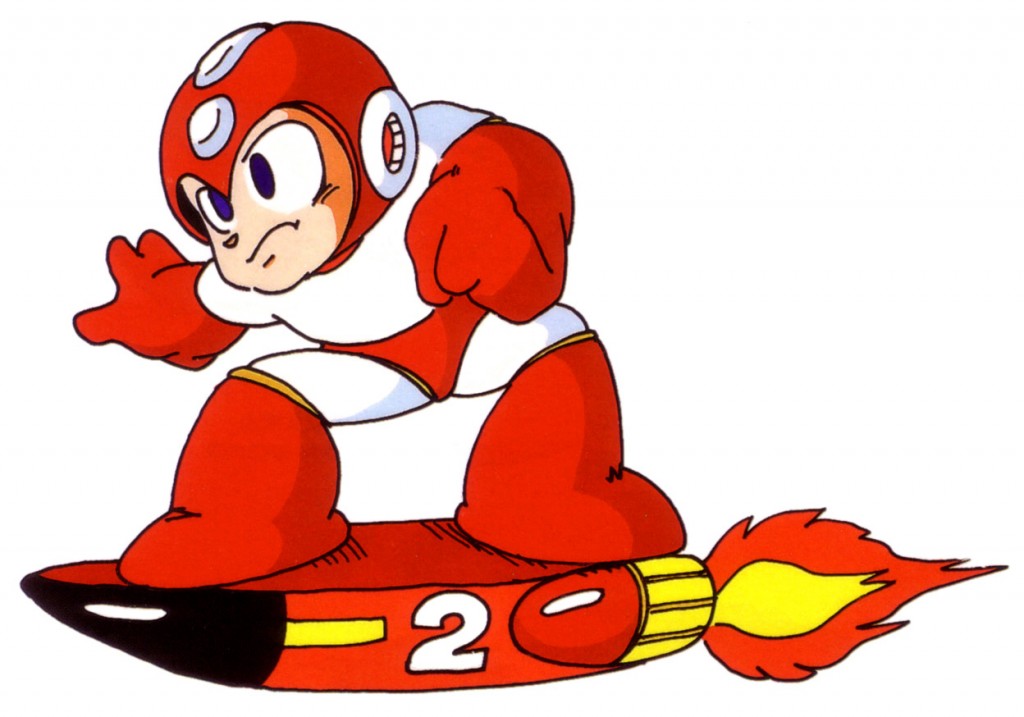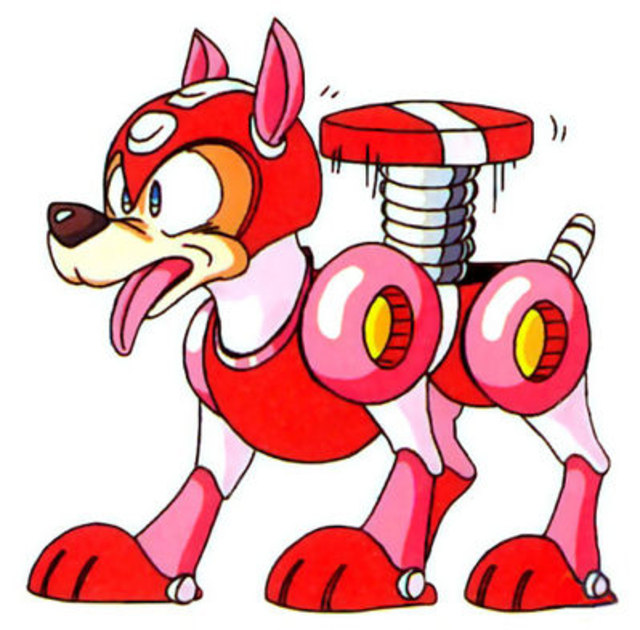Last updated on October 29, 2013
Hey, if you can’t pick between them, why not choose both?
Rockman, or Mega Man as it’s known in the West, captures the Japanese video game zeitgeist of the late 1980s and early 1990s. It integrates fascinating and memorable character design, interesting level structure, well-crafted enemies, the ability to select one’s own stages, and multiple weapons (unheard of in those days) to craft a memorable, longlasting experience. Hearkening to Capcom’s speciality at iterative design, however, Mega Man 1 was only a portent of things to come: Mega Man 2 and its followup eventually gained the mantle of ‘best Mega Man game ever” by just about every possible source and publication. I will offer no opinion to the contrary, even to say they’re both better than Mega Man X, a blight in my life I’ll be happy to accept. Keiji Inafune’s creation stands the test of time because of this confluence of factors, especially as a game.
But why do they succeed? What makes Rockman work so well, even if it’s totally derivative in many respects?Mega Man might not be the most innovative of the “platformers” during the halcyon days of the NES – that title goes to Super Mario Bros. – but its revelation lies in a few different aspects of the game. First, all Mega Man games, including the first, rest upon the restrictions of the NES. This might not seem like a good thing; after all, modern video game developers have all the freedom in the world to create designs of a vast imagination, so why wouldn’t this help? Look at some of Keiji Inafune’s designs from the original Mega Man and you might think “these would look better in today’s games”. Well, here’s a counterexample:
The basic design of Mega Man games come from cartoon characters that Inafune watched in his youth like Osamu Tezuka’s Astro Boy series (originally a manga) and Mazinger Z (known as Tranzor Z, but basically a giant robot anime like the Gundam series without as much substance – personal opinion alert!). This allowed the game to appeal to children, mostly, but also infuses the entire game series with the whimsy of a Saturday morning cartoon – I suppose this particular influences finds just as many fans on the Atlantic as it does on the Pacific, reigning in American as well as Japanese fans. Inafune cites these cartoon sensibilities as ingrained in many of the artists working on Rockman games
Inafune’s design is simple, elegant, and reveals exactly why his characters work, and why the artists who work on Mega Man adhere to the exact same design template. Matt Groening, in creating his Simpsons family, took as a general rule that if they were to be memorable characters, they needed to be able to work in silhouette. While this isn’t an exact comparison, it’s easy to see that Mega Man displays a striking image owing to the recognizable nature of the character at a glance. It’s the same case as a Mario or a Sonic, and what doesn’t work with Crash Bandicoot or the hundreds of other “mascots” for companies that never really captured the hearts of gamer everywhere. Lastly, the design has childish elements, but it isn’t totally cutesy like some can become. It’s difficult to quantify this, but the difficulty in appealing to all audiences lies in either making the character too cutesy, making him only appeal to a younger crowd:
Or the opposite error, making him look too adult and manly, thus becoming a bit unsettling to a younger audience:
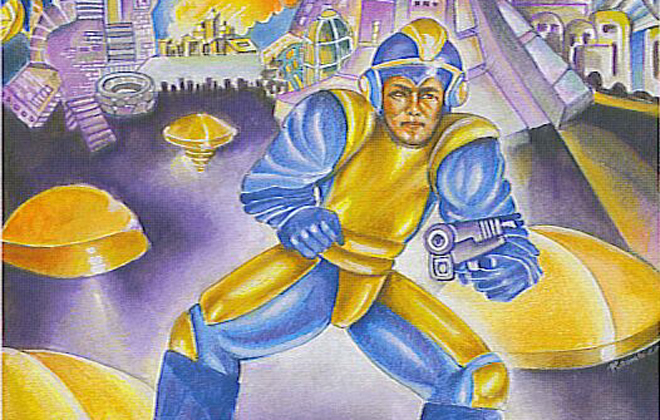
Hence, Inafune’s design succeeds on both fronts. While character design, you could say, becomes a small piece of the overall gaming puzzle, it helps to understand a character’s enduring popularity. He works because he can be identified as a cartoon character who can perform amazing feats, and a super-fighting robot (har har) who can destroy whatever evil lies in his path if necessary. It takes a lot to make a character that works, but Inafune nailed it on the head. Even this:
works if given the right context. This also shows how limitations actually help the designers. Most great works of art are built by rules and constraints that are self-imposed on the artist. The NES, according to Inafune talking about Mega Man 1, presented many limitations in the process:
The man who set this whole project on its feet is a really strict guy, and at the same he knows exactly what he wants, and is not willing to settle for anything less. Most of what I know about making games, I learned from him. At hardware, the NES can be pretty weak, so we often had to twist our brains to figure out how to do what we wanted. Yellow Devil, for example, was such a physically large character, and we knew it would be too boring if all we had was an expressive background and projectiles as weapons. That’s when he would tweak this and that, pulling out every trick in his hat to bring the game up to another level. I often found myself saying things like “Seriously!? You can do that?” and “So this is how games are made…” while I watched him work.
To make this point further, see the Yellow Devil fight in Mega Man 1:
The boss fight pretty much works self-explanatory, but imagine the planning and timing that go into making that work. You’ve got to, first, understand the timing of Mega Man’s jumps; second, determine what the weakpoint of the boss is; and third, how much damage the boss can inflict. How long are you invincible after you get hit so it’s not unfair to the player? There’s a lot of elements that go into making such an effort successful, and the original Mega Man game nails a great deal of these little, tiny details that not just any platforming game has innately. Plus, the enemy’s patterns must be easily perceived and the threat has to be possible while still retaining the art style translated into 8-bits. Each component has to be made appealing and identifiable both through sound and audio to make it possible to succeed. That becomes a lot to ask for a simple action game, yet all these mechanical/aesthetic pieces all fit into a greater puzzle.
Tiny changes and design choices have much to do with Mega Man’s success as a game, not just as an aesthetic exercise. Mega Man, according to Egoraptor, has a specific jump arc that was actually copied into Mega Man X because, hey, it works. For every platformer, there’s a specific jump speed, arc, and falling speed that has to be monitored. Furthermore, the design of the stages has to support this mechanic or else the stages don’t work properly. Bubsy, a forgotten mascot game, has a high jump mechanic, but the levels fix the camera too close to make the jumping easy – in fact, many times you can jump and die offscreen through no fault of your own. Mega Man makes these death entirely your fault. You can learn from your mistake the next time and proceed. Many Mega Man levels also contain “training” sections – they present the obstacle in a somewhat safe environment that allows you to have a preview of the next sections of the level. Take, for example, the Hammer Joe enemy from Mega Man III:
Basically, Hammer Joes swing the “hammer” around their head for a set amount of time. At the end of their swinging, their eye will begin changing color and release. It is at this point that they are vulnerable to attack, and at this same time they will also release the hammer. If you get hit, you take damage. The point, though, is that you actually learned how to defeat the enemy through trial and error in the context of the level.
Thus, the next time, you’ll find a different method to kill the enemies more efficiently without taking damage yourself. You might jump. Or you might slide (as Mega Man 3 has). Either way, you’ll use a technique, learn the timing, and defeat the obstacles. It doesn’t feel cheap or broken because the developers taught you how to play without you realizing that a tutorial was happening. Mega Man games teaches you how to play without any real nudging from the game; we don’t need text boxes or lengthy teaching sessions because we teach ourselves.
Second, the game rests on one mantra: “A system that utilizes simple control but offers deep gameplay”. I hate the neologism “gameplay”, but the quote tells you all you need to know. The jump system and the like contribute to this complexity because it offers enough variation for the player to use. The levels, furthermore, work with the limitation of the player. For example, why doesn’t Mega Man crouch? Inafune says:
I often heard people say, ‘Mega Man can’t crouch,’ but we actually had a dot graphic of him crouching while we were working on ‘1’…On the NES, with only a split second to see the slight height difference, the player wouldn’t really be able to differentiate between a projectile that could only be dodged by jumpng, and one that could only be dodged by crouching. That was the reason why we decided to go with a jumping-only system for Mega Man 1 and 2, and I think we did a good job refining it.
Honestly, who would have thought that crouching was a design choice rather than an oversight? True enough, the crouching in Mega Man X5 and onward, for example, doesn’t work as well as it should for exactly this reason. This means the game can throw an overwhelming amount of bullets and shots at the player, who now has to worry about several different angle of attack that are randomized. While this might work in, say, a bullet-hell shooter like Espgaluda, it simply has no place in the design of a Mega Man game. It engenders lazy level design. If you give a player too many tools, it becomes difficult to understand which one works at which time in a platforming game. You get “cheap deaths” that impose impossible situations on the player, who can smell that kind of problem a mile away. X6 exacerbates this problem even further, as the enemy attack patterns come at all places at all times, and many are unavoidable without memorization.
Mega Man does not encourage memorization. If it did, I would imagine it’s popularity would never have come to pass. Rather, it engenders a combination of reflexes, instinct, and skill. It tells you to learn things, not to memorize, and that’s to the game’s credit. Is memorization a bad thing in games? Absolutely not! Some games work solely because memorizing patterns is an interesting mechanic, especially if the patterns of a boss or enemies vary with time. Rather, Mega Man presents systems that a player doesn’t have to memorize, simply because he or she has been given the tools to deal with new and different obstacles over the time spent playing the game. That’s a mark of good design.
Lastly, the aspect of choice becomes an essential part of the experience. I suppose we could add “getting stronger”, but I’m not sure if that’s exactly the feeling. Weapons add variety and interesting level design to accommodate those weapons; they can’t necessarily be overpowered if you get them because, if so, no one would remark upon the game’s difficulty with anything but a sigh. What they do instead is create the “weakness chain” that most people remark is interesting about Mega Man. Each boss holds a particular weapon suited to his name and skills; by defeating him/her, you gain that weapon. One boss will be weak against one of the other weapons; thus, the trick is to start with the easiest boss and experiment with the others. Back in the day, we couldn’t just look up the pattern, so this adds an element of educated guesses and inference to the mix. You could certainly guess that, maybe, fire would be weak to water, and ice to fire, but it isn’t that simple once we talk about Robot Masters (as the bosses of levels are called) that don’t have an obvious elemental weakness. What weapon works against Quick Man? Well, what can slow him down? They’re simple little puzzles that make sense only when you know what a Robot Master’s weapon actually does, another simple layer. Starting to observe these layers shows that they’re not complex, but they add to a lot of the fun.
Full disclosure: I’m a hoarder when it comes to Mega Man weapons. In fact, except for the bosses, I never use them unless absolutely necessary. I realize this probably isn’t what the designer intended, but I use the Mega Buster (the default weapon) as often as possible to preserve the weapon energy of everything else. I imagine it’s a subconscious thing rather than an active decision on my part, but I play the game as strictly as possible in that regard. That’s not a bad thing, though! If you want to play around with bombs, ice shards, cut boomerangs and the menageries of different devices, more power to you; the game isn’t limiting the player’s abilities by presenting weapons in any way. Rather, you can “play your own way” in the context of the game’s systems, and the developers won’t punish you because it works within these caveats. Thus, as far as weapons being “useful” in later Mega Man games, I can’t say if that’s true because I don’t use them. Maybe that’s why I like even the later entries in the series, such as 4, 5, and 6 – these have pretty useless weapons except for killing bosses, as far as I’ve read.
However, Mega Man 1 was never perfect in this regard either. Some of its content shows the developers creating a new game for the first time with the vestiges of the old arcade systems still in place. Note on the top of the screen the “score”, which doesn’t actually do much of anything in this game. If it wasn’t designed for the arcade, why is that in there, anyway? Some of the segments use excessive vertical level design that, frankly, bogs the segments down when you fall down two or three segments of the whole level. Later levels require the use of items or weapons – and if you didn’t know that in advance, you can’t make it any further in the level. Capcom’s first try, for whatever reason, never seems to surpass expectations. They always take a good idea, make a competent first effort, and then reformulate the game in a way that completely exceeds expectations.
Thus, Mega Man 2 is on the list, and not the first game. If the first game represented the first iteration of a true “Jump’n’Shoot Man” formula, Mega Man 2 gives the player more options than the first game, and simply integrates every element into a more holistic experience. Like any good sequel, it adds more and more devices and mechanics to enhance the game, and almost nothing detracts from it. As far as a game made in three months can be, Mega Man 2 represents the pinnacle of the formula. First, many more obstacles and traps are presented to the player; as a response, the developer gives several Items (1,2, and 3), usually used as platforms to navigate the tougher platforming sections (the dissapearing blocks of Heat Man’s stage, for example). The enemies hit harder and come in greater numbers, but E tanks allow players of most skill levels to succeed without having to restart the game, like the original. This was an interesting design choice; most games demand perfection, but this one said “you can make mistakes” and still live. Even Inafune’s mentor wasn’t sure whether E tanks were a good idea – however, letters to the Capcom office suggested that not every person could attain the level of skill required to beat the last levels of the first game without taking hits.
I’m sure arcade purists would come up at arms against the game for this reason, but it’s totally consistent with the design philosophy at work. If you want to teach a player to play the game, the E-Tank allows them to continue playing in a situation where they may die and have to return to the beginning of the level. It’s a balance between the need for accessibility and the need for difficulty; as with everything in the Mega Man series, the use of E-Tanks is purely optional in Mega Man 2. As for me? I don’t, nowadays. When I was younger I would as I didn’t have the requisite skill set. Now I create arbitrary challenge for myself because I like playing that way (same with not using weapons against bosses).
For level design, many of the vertical sections have entirely disappeared, replaced by horizontal platforming that complicate the obstacles with additional enemies, traps, and contexts. Let’s say the level are memorable in the sense described above because they add many of these “learning” moments into the game. Furthermore, these learned obstacles go right into the final levels, which mix these skills together and test the player’s knowledge of the game. That’s why Mega Man 2 becomes so satisfying, as it tests everything the player learns repeatedly and constantly. The Wily levels after the initial eight are there simply to challenge you with the tools and skills you gained in the rest of the game. By the end, facing Dr. Wily as an alien, your ability to dodge, shoot, and avoid damage becomes paramount to survival, and it’s all up to you (and too many E-Tanks, depending). Thus, it doesn’t feel like you had to memorize: you learned, adapted, and fit everything into your own playstyle, and came out victorious.
That’s why Mega Man 2 succeeds – it adds to a formula, and those additions don’t detract from the game. Mega Man 3, on the other hand, adds even more stuff and does it well. Inafune doesn’t appear too pleased with many aspects of the game, but Mega Man 3 adds additional mechanics that keep the mantra of simple complexity. Mega Man gains the slide move, an active alternative to crouching motions. While enemies usually don’t attack in a high/low fashion, it usually works as an additional move and is required in some levels (which will indicate where to slide, in most cases, simply by visual appearance). Of course, a slide can be used offensively under an enemy, as well, making it both an offensive and defensive option in combat.
As well, the game adds additional personality by turning the Items into Rush, Mega Man’s faithful robot dog. Now he turns into the items necessary for progress in some of the stages (the Doc robot ones, anyway). Protoman, a nemesis and friend, appears throughout as a tiny test of skill for some players, and he basically forces old Mega Man veterans to learn to slide repeatedly, again showing design elegance. The Doc Robot levels are especially ingenious, as they co-opt elements of the previous game (fight the bosses again) and require you to finish levels twice as long as before, adding a new layer of challenge (again, E-Tanks can be used here if you want). The final boss is a bit of a disappointment, as he dies incredibly easily if you have the weakness, but I suppose these are the tough decisions one has to make when deciding between one game or the other.
All of this is wrapped, again, in this attractive and appealing packaging. The music, especially, reminds me of a carefree childhood, and is incredibly catchy to boot in nearly every way. Does anyone who plays video games NOT know Wily Stage 1 from Mega Man 2? Or any of the myriad themes from each level of the eight Robot Masters, each with a unique setting to go along with it? I’m pretty sure I can name any of them right from the first few bars; this is intentional because, hey, it’s “Rockman”, and Roll is his robot sister, Blues is his brother (Bass and Treble would come along later – making their names make no sense once they transplanted from Japan, but I digress). Seriously, just go look up the music on YouTube – any music Capcom made in the NES era was amazing, and Mega Man was at the peak. The music, in part, becomes just as memorable as any other part of the games.
Thus, everything together creates a Mega Man game, not just the weapons, the characters, the levels, the music, or anything else.
If anything, Mega Man games make me feel like a kid again, and that’s a pretty rare quality to have in a game. Since Mega Man really was targeted and aimed at a young market, it probably should, but not to the degree to which the fandom surrounding it has grown. The medium has had a short time to grow, yet Mega Man has retained its old fans and gained new ones in return, with the multiple series changing the formula, setting, and design, but never the appeal. Perhaps it is this element of innocence (somehow, in the midst of violent and terrible robot-on-robot violence) that gives us a little insight into Matthew 19:
13 Then some children were brought to Him so that He might lay His hands on them and pray; and the disciples rebuked them. 14 But Jesus said, “[Let the children alone, and do not hinder them from coming to Me; for the kingdom of heaven belongs to such as these.” 15 After laying His hands on them, He departed from there.
And a slight variation in Mark 10:
13 And they were bringing children to Him so that He might touch them; but the disciples rebuked them. 14 But when Jesus saw this, He was indignant and said to them, “Permit the children to come to Me; do not hinder them; for the kingdom of God belongs to such as these. 15 Truly I say to you, whoever does not receive the kingdom of God like a child will not enter it at all.” 16 And He took them in His arms and began blessing them, laying His hands on them.
We can say, in pretty much any realm of entertainment, that there is always a problem with the audience. Who is the audience for your product? What general age group wants to play this? When you present Grand Theft Auto games to the public, that audience is set in stone. That game is supposedly “more adult” in both its content and its themes. A game like Mega Man, for example, isn’t considered “adult” or “advancing the medium” simply because it contains a tired old story of good versus evil, and clearly defined good wins against clearly defined evil in the end. What’s adult, nowadays, is moral ambiguity, that things aren’t as clear as they seem, and that no answer to any moral question, if it is a question at all, is the right answer.
Mega Man, like most cartoons of the Saturday morning variety, seems quaint and outdated in its straightforward manner. I think, though, this contributes to its lasting success and its bridging most age groups. It gives that feeling of continually getting strong, of fighting a greater evil and saving the day. You’d imagine these are idea we’d want our children to have, but apparently not. No great work, in my opinion, should become instantly inaccessible to one audience or the other; it has to be universal, for if it doesn’t speak to all parts of everyone’s experience, how could it possibly be effective in what it does?
Seen in this way, restricting the “great” tag to “mature” video games represents a form of ageism, where the “simple” games are attacked for the very characteristics that make them great. A Mass Effect game, rather than Mega Man, becomes the standard because it confronts social prejudice, or something. Games are growing up, we tell ourselves. They become more like us in our adult years, unsure of exactly what they’re doing with all these new opportunities.
And yet…
The Marios, Sonics, and Mega Mans of the world continue to chug along their tracks, releasing new games, creating new fans, continuing to innovate (or, perhaps, devolve, in Sonic’s case) and try new things within a familiar mold. There is definitely a role for these games which created the high water mark. They are still entertaining, even decades after their initial release. What will we say of any BioWare or Rockstar “edgy” game twenty years from now?
Even the little children, both outside us and within us, can understand this. We understand it innately because the conflict between a good and an evil force within exists within the Law, as Romans 2 says:
14 For when Gentiles who do not have the Law do instinctively the things of the Law, these, not having [o]the Law, are a law to themselves, 15 in that they show the work of the Law written in their hearts, their conscience bearing witness and their thoughts alternately accusing or else defending them, 16 on the day when,according to my gospel, God will judge the secrets of men through Christ Jesus.
And that’s why these games continue to succeed and be memorable, apart from the fact that they’re well-designed and interesting to play. Nostalgia alone doesn’t cut it; it reminds of a simpler time and a simpler faith before all the cynicism of “real art” and “real life” creeps into the picture. They’re not the reminder of a bygone era; they are what was true about reality, and what was really fun about video games. Being able to participate in that fight for justice becomes endemic to the medium. Even Christianity never was difficult for me to understand as a child. Even the little children can enter into the Christian life. Why should they be restricted? Christianity isn’t ageist; neither should video games try to fit in the same ideas. Mega Man appeals to all because it should, not because it’s “made for kids”, though it is, but because everyone can enjoy it. That’s why I play them, years and years after release.
Should the Rock/Mega Man series go on? That question has been asked long enough, but they’ve suddenly stopped all production due to Keiji Inafune’s resignation from the company and the formation of his own, Comcept, in its place. The much anticipated Mega Man Legends 3 was cancelled unceremoniously, as was Mega Man Universe. It’s pretty dissapointing, to say the least, what has happened to Capcom’s flagship star, relegated to a few camoes here and there, but not really integrated as anything other than a joke character. Of course, Inafune had thought of this question before, but when he goes to a children’s event and see their smiling faces, he told himself “I have to work harder”. What more can you ask? Mega Man will live on.

